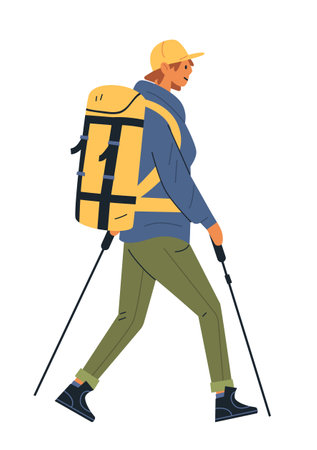Understanding American Trail Climates and Microclimates
When it comes to hiking in the United States, one thing is certain: no two trails are exactly alike when it comes to weather. From misty mornings in the Pacific Northwest’s rainforests to the dry heat of the Southwest deserts, and from muggy Appalachian summers to sudden snow squalls in the Rockies, you’ll find a huge range of climates and microclimates across America’s trail systems.
Why U.S. Trail Weather Can Be So Unpredictable
The sheer size and diversity of the U.S. mean that even within a single region, weather can shift quickly. You might start your hike under blue skies but finish with rain or even snow. Elevation plays a big role too—temperatures can drop rapidly as you climb higher, especially in mountain ranges like the Rockies or Sierra Nevada.
Common Trail Climates Across the U.S.
| Region | Typical Weather | Key Considerations |
|---|---|---|
| Pacific Northwest | Frequent rain, cool temps, fog | Stay dry; watch for slippery trails |
| Rocky Mountains | Cool to cold, sudden storms, high winds | Layer up; be ready for fast changes |
| Desert Southwest | Hot days, cold nights, low humidity | Sun protection; pack extra water; layer for chilly evenings |
| Southeast/Appalachians | Warm, humid, afternoon showers common | Breatheable layers; quick-dry fabrics; bug protection |
| Northeast/New England | Mild summers, chilly fall/spring, wet conditions possible anytime | Waterproof layers; warm mid-layers in shoulder seasons |
What Is a Microclimate?
A microclimate is a small area where the weather differs from the surrounding region. For example, a shaded ravine may stay cool and damp all day even if it’s hot and sunny elsewhere on the trail. Knowing about microclimates helps you prepare for sudden shifts—like packing an extra layer for that windy ridge or waterproof gear for creekside stretches.
The Importance of Being Prepared on American Trails
No matter where you hike in the U.S., being prepared for changing trail conditions isn’t just smart—it’s essential for safety and comfort. That’s why understanding local climates and how quickly they can change is step one in successful layering. With the right approach to dressing for your hike, you’ll be ready for whatever Mother Nature throws your way.
2. The Layering System: Basics Every U.S. Hiker Should Know
When you’re hiking in the U.S., weather can change fast—one moment its sunny, the next its chilly or raining. That’s why the layering system is your best friend on the trail. Here’s how to break it down and what works best for popular American hiking spots.
The Classic Three-Layer Approach
The classic layering system has three parts: base layer, mid layer, and outer layer. Each plays a special role in keeping you comfortable, dry, and protected.
| Layer | Main Purpose | Best Fabrics | Popular U.S. Region Examples |
|---|---|---|---|
| Base Layer | Wicks sweat away from skin | Merino wool, synthetic (polyester) | PCT in California, Smoky Mountains in Tennessee/North Carolina |
| Mid Layer | Traps heat to keep you warm | Fleece, lightweight down, synthetic insulation | Rocky Mountains in Colorado, Cascades in Washington/Oregon |
| Outer Layer | Protects from wind and rain | Waterproof/breathable shell (Gore-Tex, eVent) | White Mountains in New Hampshire, Olympic National Park in Washington |
How to Pick the Right Layers for Your Adventure
Base Layer Tips
- Cotton is not your friend. It holds onto moisture, so stick with moisture-wicking fabrics like merino wool or polyester.
- Hotter hikes? Go with lightweight and breathable options—think Arizona’s Grand Canyon or Utah’s Zion National Park.
- Colder climates? Choose midweight merino for warmth without bulk.
Mid Layer Choices Matter
- Mild days: A simple fleece jacket is perfect for places like Shenandoah National Park.
- Bitter cold: Go for a puffy down or synthetic jacket if you’re tackling Colorado’s high-altitude trails.
- If weight matters: Synthetic insulation stays warm even when wet—great for the rainy Pacific Northwest.
The Outer Layer: Your Weather Shield
- Packed for rain? Always bring a rain shell—weather can turn quickly in places like the Appalachian Trail or Great Smoky Mountains.
- Cuts the wind: Even a lightweight windbreaker helps above treeline in exposed areas like Mount Whitney or Mount Rainier.
- Pit zips or vents: Look for jackets with ventilation if you’re going to work up a sweat.
Packing Tips by Region:
- Sierra Nevada & Rockies: Layers are key; mornings are cold but afternoons heat up fast.
- Pacific Northwest: Waterproof outer layers are a must—expect rain anytime!
- Desert Southwest: Lightweight base and mid layers; pack a sun-protective shirt as your “outer” layer during the day.
- Northeast: Be ready for humidity and pop-up storms with quick-drying layers and a solid rain jacket.
This three-layer system lets you mix and match based on where you’re hiking, so you’ll stay comfortable no matter how wild the weather gets out there!

3. Choosing Fabrics and Gear: What Works Best Stateside
Understanding Your Fabric Options
When it comes to layering for unpredictable trail conditions in the U.S., picking the right fabric is key. American hikers often debate between natural fibers like merino wool, synthetics such as polyester blends, and advanced materials like GORE-TEX. Each has its pros and cons, especially when you’re covering diverse terrain or facing sudden weather changes.
Popular Fabric Choices for U.S. Trails
| Fabric Type | Best For | Main Benefits | Common U.S. Brands |
|---|---|---|---|
| Merino Wool | Base Layers | Soft, moisture-wicking, odor-resistant, good temperature control | Smartwool, Icebreaker (widely available at REI) |
| Synthetic Blends (Polyester/Nylon) | Base & Mid Layers | Fast drying, lightweight, durable, budget-friendly | Patagonia Capilene, Columbia Omni-Wick |
| GORE-TEX & Waterproof Membranes | Outer Shells/Jackets | Windproof, waterproof yet breathable, reliable in storms | The North Face, Arc’teryx, Marmot PreCip |
| Fleece (Polyester) | Mid Layer | Warmth without weight, quick-drying, affordable options | REI Co-op Fleece, Patagonia R1/R2 |
| Nylon/Softshells | Pants & Lightweight Jackets | Tough against abrasion, flexible, good for scrambling or brushy trails | Kuhl Renegade Pants, Prana Stretch Zion |
Real-World Tips from American Hikers
- Mornings in Colorado Rockies: Start with a merino base for warmth and add a synthetic fleece mid-layer. Keep a GORE-TEX shell handy for afternoon rain or wind.
- Summer in California Sierras: Synthetics shine here—opt for light polyester shirts and pants that dry fast after stream crossings.
- Pine Forests of the Pacific Northwest: Pack a waterproof-breathable jacket (think GORE-TEX) because showers can appear anytime—even on sunny days!
- Southeastern Appalachians: High humidity? Merino helps prevent clamminess and odor during long days on the trail.
Shopping Stateside: Where to Find Reliable Gear?
You’ll find these fabrics and brands at major outdoor retailers like REI, Backcountry.com, Dick’s Sporting Goods, or local gear shops across the country. Many American-made options support local economies while offering top-notch performance for your next adventure.
4. Adjusting on the Fly: Trail-tested Tips for Rapid Weather Swings
Hiking in the U.S. means you’ll face everything from blazing sunshine in Utah’s Zion National Park to sudden hailstorms in Colorado’s Rocky Mountains. No matter where you hit the trail, knowing how to adjust your layers quickly can make or break your adventure. Let’s break down some practical ways to stay comfortable when the weather flips in a heartbeat.
Elevation Changes: Layering Like a Pro
As you climb higher, temperatures usually drop and winds pick up. Here’s a quick guide on what to do:
| Elevation Change | What to Do | Layer Suggestion |
|---|---|---|
| Starting Low (Warm) | Wear just your base layer and maybe light shorts | Moisture-wicking T-shirt, lightweight hiking pants/shorts |
| Mid-Elevation (Cool Breeze) | Add a mid-layer as soon as you feel chilly | Fleece pullover or synthetic hoodie |
| High Elevation (Cold/Windy) | Throw on a windbreaker or insulated jacket fast | Windproof shell, beanie, gloves |
Sudden Storms: Fast Fixes When Skies Open Up
If dark clouds roll in—like they often do on the Appalachian Trail—don’t wait until you’re soaked. Keep your rain shell accessible (not buried deep in your pack). Here’s how to handle surprise showers:
- Quick Grab: Store your rain jacket in your pack’s top pocket or side mesh for easy access.
- Poncho Power: In heavy downpours, throw on a poncho over everything—even your backpack.
- Pit Zips & Vents: If your shell has vents, open them up during humid storms to avoid overheating.
- Shoe Swap: On muddy trails, consider swapping into waterproof trail runners or gaiters if you packed them.
Temperature Drops: Keeping Cozy Without Missing a Step
The temperature can drop fast at dusk or after a summer thunderstorm. To stay comfortable:
- Add Layers Before You Chill: As soon as you stop for a break or notice temps dropping, put on an extra layer right away—it’s easier to stay warm than get warm again.
- Mittens Over Gloves: Carry both; mittens are warmer if things get really cold.
- Neck Gaiter Trick: A simple neck gaiter can double as a hat or face cover when the wind picks up.
- Puffy On Standby: For cold snaps above tree line (like in California’s Sierra Nevada), keep an ultralight puffy jacket ready to grab instantly.
Packing for Quick Changes: Expert Tips from U.S. Trails
- Ditch Cotton: Wet cotton chills fast—always stick with synthetic or wool layers.
- Zippered Pockets Rule: Stash gloves, hats, and snacks where you can reach them without taking off your pack.
- Tie Layers Around Your Waist: For quick swaps during variable temps, tie that fleece around your waist so it’s handy whenever you need it.
- Laminated Cheat Sheet: Some hikers carry a small card reminding them which layer to add/remove based on weather signs—super helpful for new hikers!
Your Trail Experience Matters Most
No two hikes are ever the same, especially on iconic U.S. trails like the Pacific Crest Trail or Smoky Mountains’ Alum Cave Trail. Practice these quick layering strategies during short hikes so youre ready for anything nature throws at you on bigger adventures!
5. Planning Ahead: Packing and Local Resources
Building a Reliable Packing Checklist
When it comes to layering for changing trail conditions, having a packing checklist can make or break your adventure. A good checklist ensures you’re prepared for anything the weather or terrain throws your way. Here’s a basic guide to help you get started:
| Layer | Essential Items |
|---|---|
| Base Layer | Moisture-wicking shirt and underwear (synthetic or merino wool) |
| Mid Layer | Insulating jacket or fleece (consider warmth and breathability) |
| Outer Layer | Waterproof/windproof shell (lightweight rain jacket or hardshell) |
| Accessories | Hat, gloves, neck gaiter, extra socks |
| Other Essentials | Map, compass/GPS, headlamp, snacks, water bottle/hydration system |
Where to Check Local Trail Forecasts
Weather in the U.S. can change quickly, especially in mountainous areas like the Rockies, Sierras, or Appalachians. Before you hit the trail, it’s smart to check local forecasts and trail conditions. Here are some trusted resources commonly used by American hikers:
- National Weather Service (weather.gov): Offers detailed regional forecasts and alerts.
- AllTrails and Gaia GPS apps: Provide real-time trail reports from other hikers.
- Local ranger stations or visitor centers: Staffed by people who know the area best—call ahead for up-to-date info.
- Noaa.gov: For more technical mountain weather predictions.
Outfitter Shops: A U.S. Hiking Staple
If you realize you’re missing something from your layering system or want local advice, American outfitter shops are great places to stop before hitting the trail. Stores like REI, Bass Pro Shops, Cabela’s, and local gear shops can help you:
- Find last-minute clothing or gear tailored to the region’s climate.
- Get recommendations on what layers work best for current conditions.
- Ask about any recent changes in trail conditions from staff who often hike locally themselves.
- Rent equipment if you don’t want to purchase new items for a short trip.
Packing Tip:
Aim for versatility with your layers so you can adjust as temperatures shift—think lightweight pieces that easily pack away in your daypack. By planning ahead and using these resources, you’ll be ready for whatever the trail brings!


